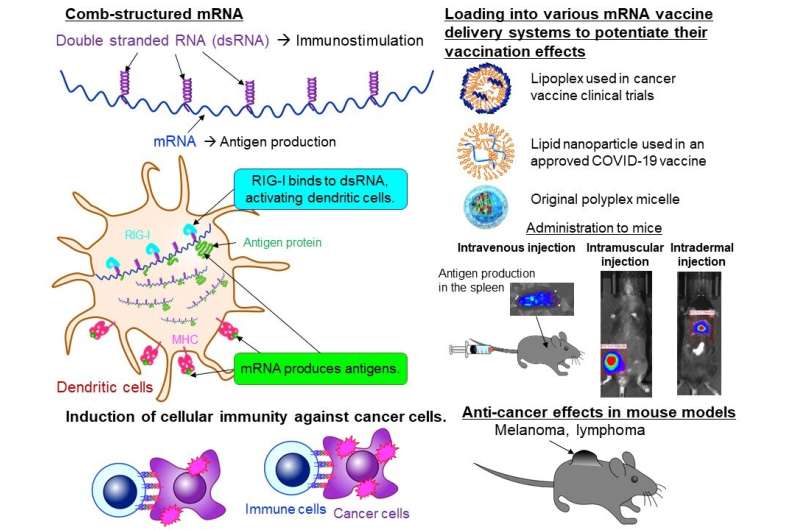
A multi-institutional collaborative has developed a novel mRNA derivative and demonstrated its high cellular-immunity-inducing anti-cancer activities in a mouse model. This novel mRNA, with a comb-like structure and double-stranded RNA in the shape of teeth, activates immune cells and demonstrates high anti-tumor effects in experiments using melanoma and lymphoma model mice.
The paper, titled “Comb-structured mRNA vaccine tethered with short double-stranded RNA adjuvants maximizes cellular immunity for cancer treatment,” was published online in the Proceedings of the National Academy of Sciences on July 10, 2023.
The efficacy and safety of mRNA vaccines have been demonstrated against novel coronaviruses, and research is currently underway worldwide to target cancer cells as the next target. This cancer mRNA vaccine provides cellular immunity to attack cancer cells by administering mRNA that produces a protein specifically expressed in cancer cells (cancer antigen). However, cancer cells are difficult to distinguish from normal cells and have immunosuppressive effects, making the development of cancer vaccines more challenging than vaccines against infectious diseases.
Therefore, strategies to enhance the efficacy of cancer mRNA vaccines are necessary, and in this study, the researchers focused on adjuvants for immune activation. If the adjuvant is too strong, it causes adverse reactions, while if it is too weak, it does not provide sufficient vaccine effect. The adjuvant function has been incorporated into previous mRNA vaccines empirically, lacking rational and practical methods to obtain controlled adjuvant activity thus far.
In this study, the researchers have developed a method of incorporating adjuvant directly into the mRNA chain encoding the antigen without interfering with the ability of the antigen protein production, using an original RNA engineering technique. Short double-stranded RNA (dsRNA) targeting the innate immune receptor retinoic acid-inducible gene I (RIG-I) was designed and loaded into the mRNA strand by hybridization. They obtained optimal comb-structured RNA, effectively activating RIG-I by changing the length and sequence of dsRNA.
The resulting comb mRNA effectively activated dendritic cells, which play an important role in vaccine efficacy. Furthermore, by changing the number of dsRNAs bound to the mRNA strand, the immunostimulation intensity could be controlled. This is important to prevent excessive immune activation and ensure safety while achieving sufficient vaccine effect.
Next, they evaluated the efficacy of comb mRNA as a cancer vaccine using mice. When comb mRNA was loaded onto lipid nanoparticles, which are used in clinical trials for cancer vaccines, the activity of cellular immunity, which is necessary to attack cancer, was dramatically enhanced. As a result, tumor size was reduced in skin cancer and lymphoma models, and mice’s lives were prolonged.
Another important practical aspect of this method is that comb mRNA can be loaded into various mRNA vaccine delivery systems to enhance their efficacy. The researchers succeeded in improving vaccine efficacy by loading the comb mRNA into lipid nanoparticles used in a commercial novel coronavirus vaccine and our original polymeric nano-micelles. Thus, the system is a simple and practical platform that can safely improve the efficacy of mRNA cancer vaccines in various formulations by freely controlling the adjuvant function of mRNA vaccines.
Until now, there has been no method to precisely control and rationally incorporate the adjuvant function, which is important for cancer mRNA vaccines, into vaccine design. As a result, the researchers had to rely on an empirical method in which a vast number of candidate compounds are tested in animal experiments to find the optimal one. This approach complicated the development process. To solve this issue, the researchers incorporated reasonably necessary amounts of adjuvant function into an mRNA vaccine via mRNA engineering. Using this method, the adjuvant function can be easily incorporated into various mRNA vaccine delivery systems, resulting in enhanced functionality of cancer vaccines.
Future outlook
In this study, the utility of comb mRNA was demonstrated in various mRNA vaccine delivery systems, including lipid nanoparticles, such as those used in cancer vaccine trials and in the novel coronavirus vaccine that is now in practical use. In other words, comb mRNA is a versatile system that can enhance the efficacy of any mRNA vaccine already under development, and is expected to be put to practical use in the future by loading it with existing mRNA vaccine carriers. In addition, its effectiveness can also be enhanced by integrating it with vaccine technologies that are being developed independently.
Cancer mRNA vaccines are being developed at an accelerated pace around the world as the next generation of cancer immunotherapy, and comb-shaped mRNA is expected to become a core fundamental technology for enhancing their efficacy.
More information:
Theofilus A. Tockary et al, Comb-structured mRNA vaccine tethered with short double-stranded RNA adjuvants maximizes cellular immunity for cancer treatment, Proceedings of the National Academy of Sciences (2023). DOI: 10.1073/pnas.2214320120
Journal information:
Proceedings of the National Academy of Sciences
Source: Read Full Article
